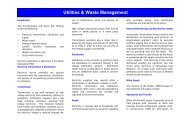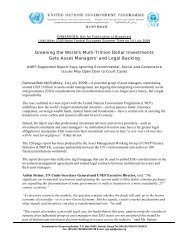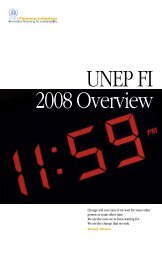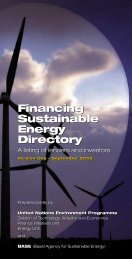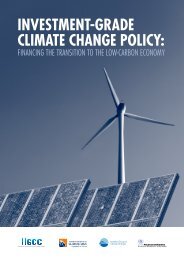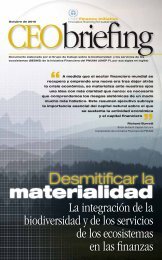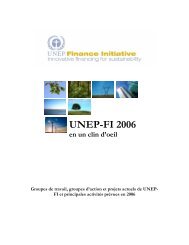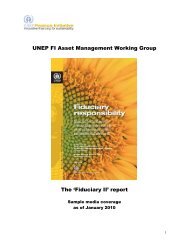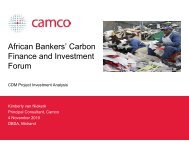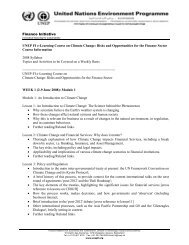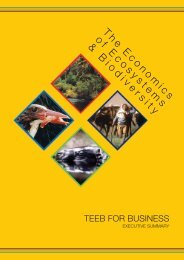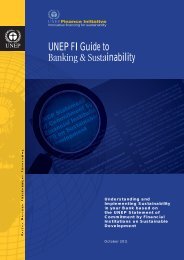Carbon 2009 Emission trading coming home - UNEP Finance Initiative
Carbon 2009 Emission trading coming home - UNEP Finance Initiative
Carbon 2009 Emission trading coming home - UNEP Finance Initiative
Create successful ePaper yourself
Turn your PDF publications into a flip-book with our unique Google optimized e-Paper software.
<strong>Carbon</strong> <strong>2009</strong><br />
Figure 2.15: A question of implementation?<br />
Evaluation of JI in 2008. Share of respondents agreeing with given statements. N=2949 (<strong>2009</strong>).<br />
35%<br />
30%<br />
25%<br />
2008<br />
<strong>2009</strong><br />
20%<br />
15%<br />
10%<br />
5%<br />
0%<br />
Source: Point <strong>Carbon</strong><br />
The JI market is<br />
a success<br />
The JI market<br />
facilitates<br />
emissions<br />
reductions<br />
The JI market is<br />
the most costefficient<br />
way to<br />
reduce<br />
emissions<br />
The JI market is<br />
mature<br />
The JI market is<br />
more mature<br />
now than one<br />
year ago<br />
has largely provided certainty<br />
about the overall use of CERs<br />
in the EU ETS until 2020, which<br />
is estimated at 1,600 Mt over<br />
the 2008-2020 period in the 20<br />
percent reduction scenario (see<br />
Chapter 4).<br />
CDM market seen<br />
as increasingly<br />
mature<br />
How do market participants and<br />
observers evaluate the CDM? We<br />
have asked a set of questions on<br />
the CDM and JI every year since<br />
2006, with the results given in<br />
Figure 2.14. Note that the 2006<br />
and 2007 surveys asked about<br />
the CDM and JI combined.<br />
This year’s result show a clearly<br />
rising trend in the number<br />
of respondents that think of<br />
the CDM market as mature,<br />
albeit from a low base. Sixteen<br />
percent “agree” or “completely<br />
agree” with this statement now,<br />
compared with 12 percent last<br />
year. At the same time, there is<br />
a corresponding drop-off in the<br />
numbers that think the CDM<br />
market is a success (31 percent,<br />
down from 35 percent) or that the<br />
CDM market is the most costefficient<br />
way to reduce emissions<br />
(31 percent, down from 36<br />
percent). Just over half agree<br />
that the CDM market facilitates<br />
emissions reductions, almost<br />
unchanged for four years.<br />
The results are similar to those<br />
given for the EU ETS above<br />
(Figure 2.6). It is possible that the<br />
economic slowdown since late<br />
2008, with its attendant falling<br />
carbon prices, has somewhat<br />
reduced the faith in marketbased<br />
mechanisms. Post-2012<br />
uncertainty may also explain<br />
the changes in evaluation of the<br />
CDM, but this does not account<br />
for the EU ETS result. We shall<br />
see that an even stronger trend<br />
is also present in the JI market<br />
(Figure 2.15).<br />
Falling carbon prices<br />
reducing faith in<br />
carbon markets?<br />
Most enthusiastic are, not<br />
unexpectedly, CDM project<br />
developers and aggregators,<br />
where almost four in five consider<br />
the CDM a success. The most<br />
scepticism is found in companies<br />
covered by CO 2 regulation,<br />
including the EU ETS and RGGI.<br />
2.4 JI and AAU<br />
Despite a lack of confidence in<br />
the transparency and reliability<br />
14<br />
All rights reserved © <strong>2009</strong> Point <strong>Carbon</strong>



